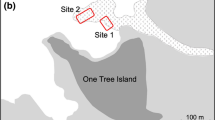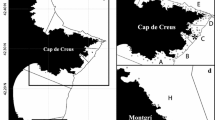Abstract
Small-scale population densities of tidal creek eastern mudsnails, Ilyanassa obsoleta Say (studied in 1986 and in 1992 at West Meadow Creek, Stony Brook, New York) corresponded more to variation in water flow velocity than to surface sediment chlorophyll a. Higher densities were found at low flow sites. Short-term behavioral responses are likely to be responsible for density variation. Experiments using laboratory flumes and field observations both demonstrated that the snails responded to strong flow by burrowing into the substratum. Burrowing may prevent dislodgment from the sediment surface, but it also appears to be disadvantageous since burrowed mudsnails have smaller amounts of food in their guts. Snails released in sites of periodic high flow conditions moved greater distances and were soon found near the quiet-water periphery of the creek, whereas snails released at the quiet-water periphery moved far less. It is not clear whether movement from the high flow site was through crawling or through hydrodynamic transport. Laboratory flume experiments demonstrated an active crawling movement towards areas of lower current velocity. This evidence suggests that strong bottom flow in the creek center results in a combined response of burial to avoid dislodgment and a net movement towards quiet water, which reduces exposure to the high velocity conditions of the creek center.
Similar content being viewed by others
References
Bianchi TS, Dawson R, Sawangwong P (1988) The effets of macrobenthic deposit-feeding on the degradation of chloropigments in sandy sediments. J exp mar Biol Ecol 122:243–255
Bianchi TS, Levinton JS (1984) The importance of microalgae, bacteria, and particulate organic matter in the somatic growth of Hydrobia totteni. J mar Res 42:431–443
Brenchley GA (1980) Distribution and migratory behavior of Ilyanassa obsoleta in Barnstable Harbor. Biol Bull mar biol Lab, Woods Hole 159:456–457
Brenchley G, Carlton JT (1983) Competitive displacement of native mud snails by introduced periwinkles in the New England intertidal zone. Biol Bull mar biol Lab, Woods Hole 165:543–558
Brown SC (196) The structure and function of the digestive system of the mud snail Nassarius obsoletus (Say). Malacologia 9:447–500
Cammen LM, Rublee PA, Hobbie JE (1978) The significance of microbial carbon in the nutrition of the polychaete Nereis succinea and other aquatic deposit feeders. UNC Sea Grant Publication UNC-SG-78-12, NOAA, Washington, D.C.
Carr WES (1967 a) Chemoreception in the mud snail, Nassarius obsoletus. I. Properties of stimulatory substances extracted from shrimp. Biol Bull mar biol Lab, Woods Hole 133:90–105
Carr WES (1967 b) Chemoreception in the mud snail, Nassarius obsoletus. II. Identification of stimulatory substances, Biol Bull mar biol Lab, Woods Hole 133:106–127
Connor MS, Edgar RK (1982) Selective grazing by the mud snail Ilyanassa obsoleta. Oecologia 53:271–275
Connor MS, Teal JM, Valiela I (1982) The effect of feeding by mud snails, Ilyanassa obsoleta (Say) on the structure and metabolism of a laboratory benthic algal community. J exp mar Biol Ecol 65:29–46
Crisp M (1969) Studies on the behavior of Nassarius obsoletus (Say) (Mollusca, Gastropoda) Biol Bull mar biol Lab, Woods Hole 136:355–373
Curts LA (1987) Vertical distribution of an estuarine snail altered by a parasite. Science, NY 235:1509–1510
Curts LA (1990) Parasitism and the movements of intertidal gastropods. Biol Bull mar biol Lab, Woods Hole 179:105–112
Curtis LA (1993) Parasite transmission in the intertidal zone: vertical migrations, infective stages, and snail trails. J exp mar Biol Ecol 173:197–209
Curtis LA, Hurd LE (1981) Nutrient procurement strategy of a deposit-feeding estuarine Neogastropod, Ilyanassa obsoleta. Estuar cstl Shelf Sci 13:277–285
Daemen EAMJ (1986) Comparison of methods for the determination of chlorophyll in estuarine sediments. Neth J Sea Res 20:21–28
Dauer DM (1983) Functional morphology and feeding behavior of Scolelepis squamata (Polychaeta: Spionidae). Mar Biol 77:279–285
Feller RJ (1984) Dietary immunoassay of Ilyanassa obsoleta, the eastern mud snail. Biol Bull mar biol Lab, Woods Hole 166:96–102
Forbes VE, Lopez GR (1986) Changes in feeding and crawling rates of Hydrobia truncata (Prosobranchia: Hydrobiidae) in response to sedimentary chlorophyll a and recently egested sediment. Mar Ecol Prog Ser 33: 287–294
Jenner CE (1956) The occurrence of a crystalline style in the marine snail, Nassarius obsoletus. Biol Bull mar biol Lab, Woods Hole 111:304
Jenner CE (1958) An attempted analysis of schooling behavior in the marine snail Nassarius obsoletus. Biol Bull mar biol Lab, Woods Hole 115:337–338
Levinton JS (1979) The effect of density on deposit-feeding populations: movement, feeding and floating of Hydrobia ventrosa Montagu (Gastropoda: Prosobranchia), Oecologia 43:27–39
Levinton JS (1989) Deposit feeding and coastal oceanography. In: Lopez GR, Taghon GL, Levinton JS (eds) Ecology of marine deposit feeders. Springer-Verlag, New York, pp 1–23
Levinton JS (1991) Variable feeding behavior in three species of Macoma (Bivalvia: Tellinacea) as a response to water flow and sediment transport. Mar Biol 110:375–383
Levinton JS, McCartney M (1991) The use of photosynthetic pigments in sediments as a tracer for sources and fates of macrophyte organic matter. Mar Ecol Prog Ser 78:87–96
Lopez GR, Levinton JS (1987) Ecology of deposit-feeding animals in marine sediments. Q Rev Biol 62:235–260
Miller DC, Bock MJ, Turner EJ (1992) Deposit and suspension feeding in oscillatory flows and sediment fluxes. J mar Res 50:489–520
Miller DC, Sternberg RW (1988) Field measurements of the fluid and sediment-dynamic environment of a benthic deposit feeder. J mar Res 46:771–796
Nowell ARM, Jumars PA, Self RFL, Southard JB (1989) The effects of sediment transport and deposition on infauna: results obtained in a specially designed flume. In: Lopez GR, Taghon GL, Levinton JS (eds) Ecology of marine deposit feeders. Springer-Verlag, New York, pp 247–268
Olafsson EB (1986) Density dependence in suspension-feeding and deposit-feeding populations of the bivalve Macoma balthica: a field experiment. J Anim Ecol 55:517–526
Pace ML, Shimmel S, Darley WM (1979) The effect of grazing by a gastropod, Nassarius obsoletus, on the benthic microbial community of a saltmarsh mudflat. Estuar cstl mar Sci 9:121–134
Peterson BJ, Howarth RW, Garritt RH (1986) Sulfur and carbon isotopes as tracers of salt-marsh organic matter flow. Ecology 67:865–874
Rhoads DC, Young DK (1970) The influence of deposit-feeding organisms on sediment stability and community trophic structure. J mar Res 28:150–178
Sanders HL (1958) Benthic studies in Buzzards Bay. I. Animal-sediment relationships. Limnol Ocenaogr 3:245–258
Scheltema RS (1964) Feeding habits and growth in the mud-snail Nassarius obsoletus. Chesapeake Sci 5:161–166
Strickland JDH, Parsons TR (1968) A practical handbook of seawater analysis. Bull Fish Res Bd Canada 167:1–311
Taghon GL, Nowell ARM, Jumars PA (1980) Induction of suspension feeding in spionid polychaetes by high particulate fluxes. Science, NY 210:562–564
Wetzel RL (1977) Carbon resources of a benthic salt marsh invertebrate Nassarius obsoletus Say (Mollusca: Nassariidae). In: Wiley ML (eds) Estuarine processes. Academic Press, New York, pp 293–308
Wilkinson L (1989) SYSTAT: the system for statistics. Systat, Inc., Evanston, Illinois
Author information
Authors and Affiliations
Additional information
Communicated by J. P. Grassle, New Brunswick
Rights and permissions
About this article
Cite this article
Levinton, J.S., Martínez, D.E., McCartney, M.M. et al. The effect of water flow on movement, burrowing, and distributions of the gastropod Ilyanassa obsoleta in a tidal creek. Marine Biology 122, 417–424 (1995). https://doi.org/10.1007/BF00350874
Received:
Accepted:
Issue Date:
DOI: https://doi.org/10.1007/BF00350874




